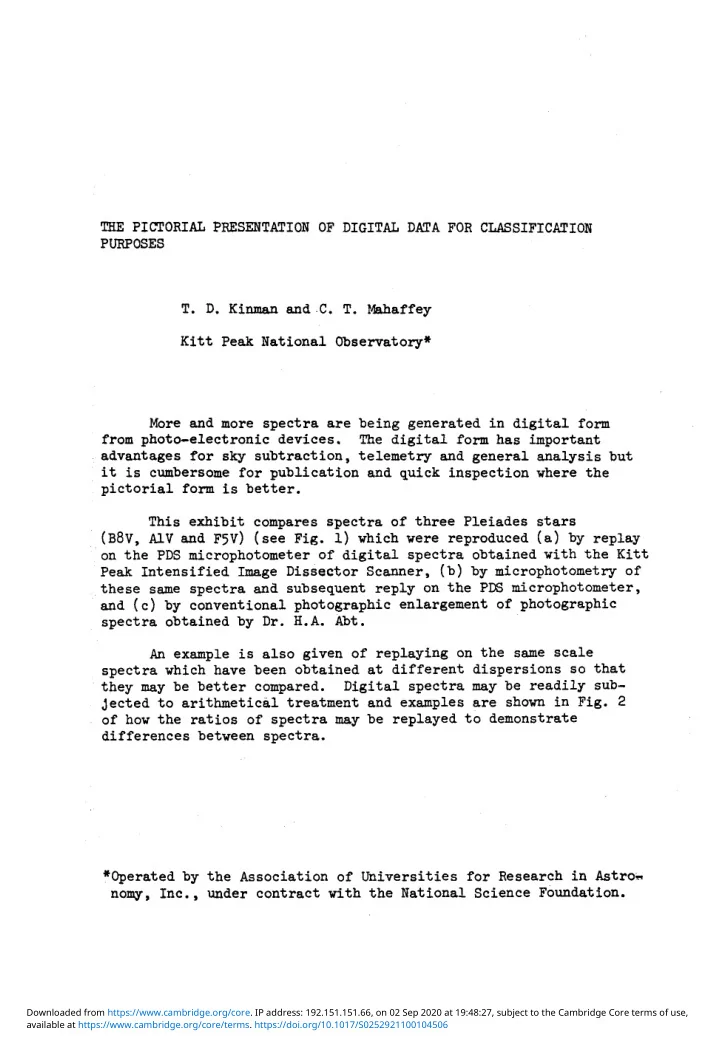

THE PICTORIAL PRESENTATION OF DIGITAL DATA FOR CLASSIFICATION PURPOSES T. D. Kinman and C T. Mahaffey Kitt Peak National Observatory* More and more spectra are being generated in digital form from photo-electronic devices. The digital form has important advantages for sky subtraction, telemetry and general analysis but it is cumbersome for publication and quick inspection where the pictorial form is better. This exhibit compares spectra of three Pleiades stars (B8V, AlV and F5V) (see Fig. 1) which were reproduced (a) by replay on the PDS microphotometer of digital spectra obtained with the Kitt Peak Intensified Image Dissector Scanner, (b) by microphotometry of these same spectra and subsequent reply on the PDS microphotometer, and (c) by conventional photographic enlargement of photographic spectra obtained by Dr. H.A. Abt. An example is also given of replaying on the same scale spectra which have been obtained at different dispersions so that they may be better compared. Digital spectra may be readily sub- jected to arithmetical treatment and examples are shown in Fig. 2 of how the ratios of spectra may be replayed to demonstrate differences between spectra. •Operated by the Association of Universities for Research in Astro** nomy, Inc., under contract with the National Science Foundation. Downloaded from https://www.cambridge.org/core. IP address: 192.151.151.66, on 02 Sep 2020 at 19:48:27, subject to the Cambridge Core terms of use, available at https://www.cambridge.org/core/terms. https://doi.org/10.1017/S0252921100104506
a : c Fig. 1. Three Pleiades stars were observed conventionally by H.A. Abt at 128 A/mm and conventional photographic enlargements are shown as (c). Microphotometer tracings of these same spectra replayed on the PDS microphotometer are shown as (b). Digital spectra of the same stars obtained with the KPNO IIDS (resolution 8 A) and replayed on the PDS microphotometer are shown as (a), (d) shows a 39 A/mm spectrum of star 510 by H.A. Abt that has been traced by the microphotometer and replayed at the same resolution as those in (b). Downloaded from https://www.cambridge.org/core. IP address: 192.151.151.66, on 02 Sep 2020 at 19:48:27, subject to the Cambridge Core terms of use, available at https://www.cambridge.org/core/terms. https://doi.org/10.1017/S0252921100104506
RATIOS r- • 510/150 388/150 388 „. - te?j£i Fig. 2. EWgital spectra can be easily processed by computer. This allows normalization, forming ratios, etc. for demonstrating spectral differences. Downloaded from https://www.cambridge.org/core. IP address: 192.151.151.66, on 02 Sep 2020 at 19:48:27, subject to the Cambridge Core terms of use, available at https://www.cambridge.org/core/terms. https://doi.org/10.1017/S0252921100104506
DISCUSSION Lynga: I was impressed by Kinman's display of photographic play- backs of spectra. The method should be good for classification of spectra with high image content and low density. I am thinking particularly of electrography, where an amplification of density is important and could be performed by PDS machines with play-back. However, there is a pitfall in that the original spectrum is a two-dimensional picture and should be scanned and played back as such. In the display there are noise details which have been registered by the one-dimensional scan and then played back as lines. Kinman: I agree that a means should be found for displaying the digital data in a way that the noise can be estimated and defects of any kind detected. It seems that several complete samples of the digital data should therefore be taken and displayed separately one above the other so that an estimate of the noise can be made as in a conventional spectrum. Downloaded from https://www.cambridge.org/core. IP address: 192.151.151.66, on 02 Sep 2020 at 19:48:27, subject to the Cambridge Core terms of use, available at https://www.cambridge.org/core/terms. https://doi.org/10.1017/S0252921100104506
Recommend
More recommend